Types of blades
When operating the grindstone, you should use enough water so it prevents damage to the knife and stone. The wheel should turn away from you and the knife edge should be facing away from you. You must not let the knife face towards you, as it can dig into the grindstone, twist rapidly and cut into your hand (knife roll).
Untrained workers should seek assistance from a supervisor or training officer.
Sometimes different edges are required for different animals to prevent damage to the knife. Often ‘lot fed’ cattle have hides with a build up of mud and faeces. Cutting through this, especially the leggers and flankers, will quickly blunt a sharp knife. You will often be better off with a thicker bevel and rough steel reserved for this task.
To get a good, flat, cutting bevelled edge, you must press firmly on the blade. Avoid placing fingers on the blade. Repeat the process on both sides until both sides are the same. The knife is now ready to be honed.
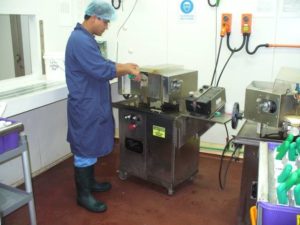
Knife sharpening machine
Hollow grinding
Hollow grinding is when you need a fine very sharp edge. This type of edge is not recommended where the knife is likely to contact bone or hard table surfaces; but it is recommended for slicing (using cutting boards) and skinning tasks. Both sides of the blade are ground to produce a slight hollow usually about 7 mm wide and finishing about 1mm from the edge of the blade. Don’t grind right down to the edge or you will have a ‘feather’ edge and that defeats the purpose.
The main advantage of hollow grinding is the ability to quickly sharpen the edge by placing the blade flat on the stone so the blade edge of the hollow is being sharpened; it also reduces knife drag, reducing effort and wear and tear on your wrists. Take care not to overuse the whetstone or you could produce a feather edge. You’ll know if you have as fine bits of the edge will come off as you steel the knife. Always check for this before you go near the product again.
Belt grinders
Belt grinders are the choice of most modern abattoirs. They are a versatile tool that can be used for flat grinding, hollow grinding and reshaping the knife.
Two important things to remember are safety and pressure.
- Safety – always use eye protection, the belt should be firmly attached not tight and rotate away from the body.
- Pressure – keep it light to prevent heat, excessive heat will burn the steel and make it brittle. Always have a water container handy and regularly cool the blade. When flat grinding hold the blade flat and just lifted up so the back of the blade is 1mm clear of the belt. The back of the blade is where the strength is so don’t grind it off.
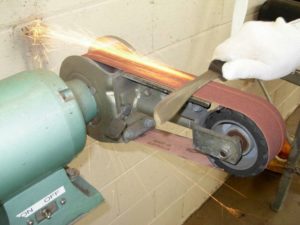
Belt Grinder
- Allow 1mm between the belt and the back of the blade. Light pressure, patience and keep the blade cool.
- Hollow grinding can be done on the curved part of the belt. Take care not to rind right down to the cutting edge. Finish the grind leaving a 1mm cutting edge to finish on the oilstone.
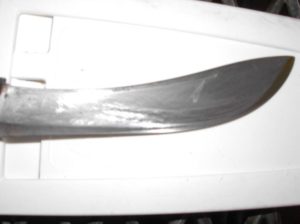
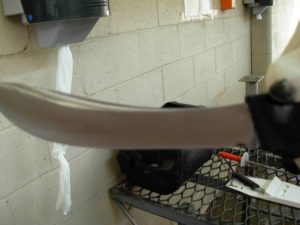
Blade prior to grinding-not the thick shoulder Finished flat blade-note the shoulder is completely gone
At this point you can decide whether or not you wish to hollow grind the blade. If you do you can use the belt sander or a hollow grinding machine.
Hollow grinding machines
These machines have two opposing wheels set at whatever grinding setting you require. They can be set extremely close for a fine cutting edge and small hollow or wide for thick knives that need a bigger hollow. Again let the machine do the work don’t force the blade through, just guide it. The machine will have cooling water or water and oil to prevent burning. Always wear your eye protection!!! And also wear your hair cover as your hair could get caught in the wheels.
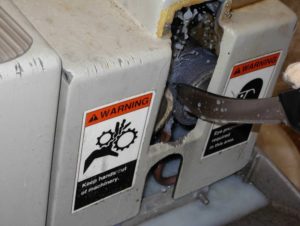
Hollow grinding machine
In this picture you can see the gap setting is at its widest – you could hollow grind a cleaver with this setting.
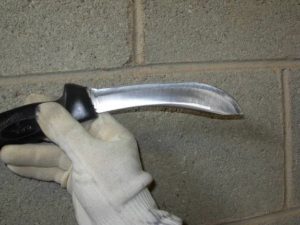
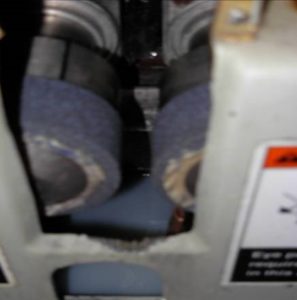
A perfectly hollow ground knife
